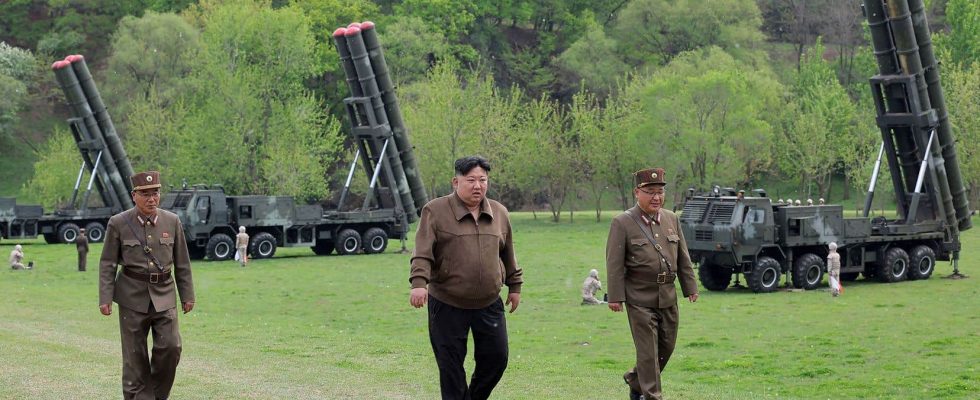North Korean leader Kim Jong-un oversaw the country’s first simulated “nuclear trigger” military exercise in response to U.S.-South Korean air drills, state news agency KCNA reported Tuesday. .
The exercises tested Pyongyang’s “nuclear trigger” management system for the first time, the agency reported, adding that it is a combined control system for the country’s nuclear weapons.
The exercise took place on Monday, according to the agency. The South Korean military announced that day that the North had fired a salvo of short-range ballistic missiles, which Japan confirmed. According to Seoul, the missiles were launched from the Pyongyang region and landed in the waters east of the Korean peninsula.
Kim Jong-un “led a combined tactical exercise simulating a nuclear counterattack involving very large multiple rocket launchers,” KCNA said. According to the agency, the projectiles “equipped with simulated nuclear warheads” hit their target located 352 km from the launch point.
The manager expressed “his great satisfaction with the result of the exercise,” added the agency.
The exercise made it possible to examine “the reliability of the command, management, control and operation system of the entire nuclear force” and to ensure that the very large multiple rocket launchers were capable of switching to nuclear counterattack mode, detailed KCNA.
“Provocative and aggressive”
According to KCNA, this simulation is a response to the annual US-South Korean air training taking place from April 12 to 26 at the Kunsan base in South Korea. Exercises that North Korea considers “extremely provocative and aggressive” and openly directed against it, the agency said.
In response, the North is forced to “strengthen its strongest military power more massively and more quickly,” notes KCNA.
The U.S. and South Korean air forces stressed that the annual exercises serve to “demonstrate the weapons’ effectiveness in the air domain and enhance their ability to deter, defend and defeat any adversary.”
Pyongyang takes a dim view of the joint military maneuvers that the United States, South Korea and Japan regularly organize in the region, seeing them as general rehearsals before an invasion of its territory or an overthrow of its regime.
The latest shot “is an exercise designed for a scenario showing how the Kim regime would respond to a surprise aerial bombardment of Pyongyang by joint U.S. and South Korean air forces,” said Han Kwon-hee of the Korean Defense Industry Studies Association at AFP.
“The exercise shows that the response could include retaliatory nuclear missiles on the South,” he added.
After a record missile test in 2023, North Korea has carried out several launches since the start of the year. The North Korean regime notably claimed in early April to have tested a new medium-to-long-range solid-fueled hypersonic missile. On Friday, he announced the test of a “very large warhead” designed for a strategic cruise missile.
Since 2006, Pyongyang has been the subject of a series of UN sanctions which have been reinforced several times subsequently, and which notably prohibit it from developing ballistic missiles and nuclear weapons.
The Kim Jong-un regime nevertheless continued its banned military programs and, in 2022, declared its status as a nuclear power “irreversible”. He has also considerably hardened his tone against South Korea, now described as the “main enemy” with whom any prospect of reunification is in vain.
In March, Russia vetoed in the Security Council a draft resolution extending for one year the mandate of the committee of experts responsible for monitoring the implementation of these sanctions.
North Korea has recently strengthened its ties with Russia, its traditional ally isolated since the start of the war in Ukraine. Washington and Seoul accuse Pyongyang of delivering weapons to Moscow in exchange for military technologies.
